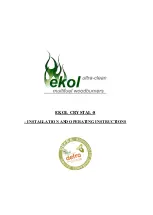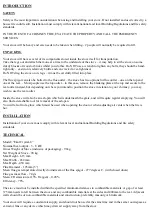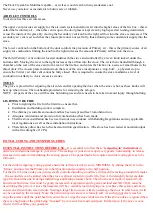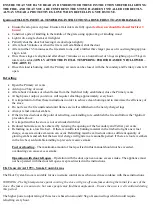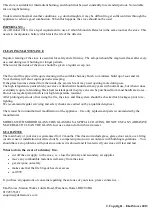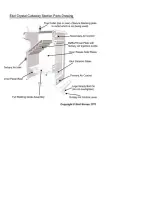
The stove should be installed on a level floor with adequate load bearing capacity.
The stove needs to stand on a hearth of non-combustible materials not less than 12mm thick conforming to Building
Regulations.
At least one permanent external air vent should be installed in the same room as the stove, to ensure a constant air
supply for combustion. It should consist of a total free area of at least 1650mm². The vent should be positioned such
that it is not liable to blockage.
NOT suitable for installation in a shared flue system.
If installed in a standard type chimney, a register plate needs to be fitted inside the chimney.
When purchasing flue pipe, 5” diameter is required. The flue pipe must be fitted INSIDE the flue spigot, and sealed
with a generous amount of Fire Cement.
Access should be provided for cleaning the flue to ensure that the passageways for exhaust gases remain free from
obstruction.
We recommend that you have a qualified fitter install your stove. The British recognised standard for solid fuel
installations is HETAS. You can find a HETAS qualified installer in your area by going to the HETAS website –
OPERATING INSTRUCTIONS
The Clean Air Act 1993 and Smoke Control Areas
Under the Clean Air Act local authorities may declare the whole or part of the district of the authority to be a smoke
control area. It is an offence to emit smoke from a chimney of a building, from a furnace or from any fixed boiler if
located in a designated smoke control area. It is also an offence to acquire an “unauthorised fuel” for use within a
smoke control area unless it is used in an “exempt” appliance (“exempted” from the controls which generally apply in
the smoke control area).
The Secretary of State for Environment, Food and Rural Affairs has powers under the Act to authorise smokeless
fuels or exempt appliances for use in smoke control areas in England. In Scotland and Wales this power rests with
Ministers in the devolved administrations for those countries. Separate legislation, the Clean Air (Northern Ireland)
Order 1981, applies in Northern Ireland. Therefore it is a requirement that fuels burnt or obtained for use in smoke
control areas have been “authorised” in Regulations and that appliances used to burn solid fuel in those areas (other
than “authorised” fuels) have been exempted by an Order made and signed by the Secretary of State or Minister in
the devolved administrations.
The Ekol Crystal-8 has been recommended as suitable for use in smoke control areas when burning seasoned wood.
Further information on the requirements of the Clean Air Act can be found here:
http://smokecontrol.defra.gov.uk/
Your local authority is responsible for implementing the Clean Air Act 1993 including designation and supervision of
smoke control areas and you can contact them for details of Clean Air Act requirements.
FUEL
Wood- All types of wood are suitable provided they are well seasoned, UNTREATED, and have a moisture level
between 12% and 20%. For soft woods, typically they will need to have been left in suitable storage for 9+ months in
order for the moisture to evaporate. For hardwoods, this will usually be 18 . It is recommended that logs
should be no more than 5” or 125mm in diameter. If you are unsure of the moisture content of your fuel, then you can
buy a moisture meter which will indicate the moisture levels in your fuel. Liquid fuels must NEVER be used.
WARNING: Wet timber should not be used as this will create excess tar deposits in the chimney and stove and could
increase the risk of chimney fire. Timber which is not of a suitable moisture content will also create more smoke and
harmful emissions, and will damage the stove and flue system.
Содержание CRYSTAL-8
Страница 1: ...EKOL CRYSTAL 8 INSTALLATION AND OPERATING INSTRUCTIONS...
Страница 7: ......

